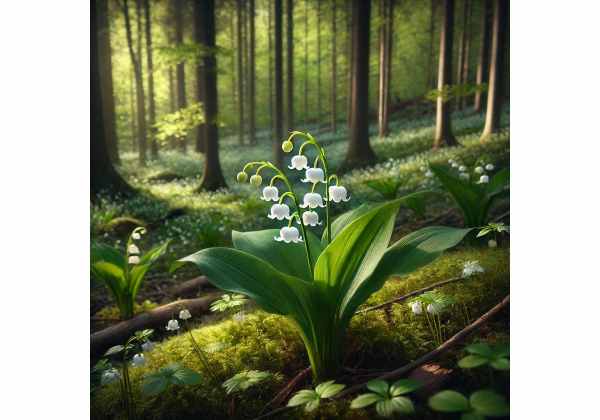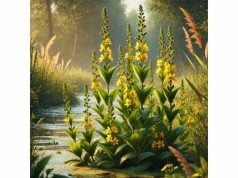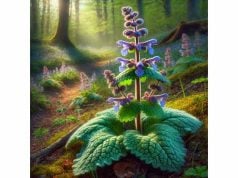Lily of the Valley (Convallaria majalis) is a captivating herb known for its enchanting fragrance and delicate, bell-shaped white flowers. Celebrated in folklore and traditional healing practices, it boasts potent bioactive compounds—especially cardiac glycosides—that contribute to its reputed benefits in supporting heart function and reducing inflammation. While its elegant appearance makes it a favored ornamental in gardens, its toxic nature demands cautious use. This guide delves into Lily of the Valley’s botanical profile, its unique chemical makeup, diverse health advantages, practical applications, and emerging scientific research, providing a comprehensive resource for enthusiasts and professionals alike.
Table of Contents
- Botanical Profile and Distinctive Features
- Chemical Constituents and Bioactive Molecules
- Health Advantages and Intrinsic Attributes
- Practical Applications and Safety Considerations
- Research Discoveries and Influential Studies
- Frequently Asked Questions
Botanical Profile and Distinctive Features
Lily of the Valley, scientifically known as Convallaria majalis, belongs to the Asparagaceae family—a group once classified under Liliaceae. This herbaceous perennial is native to the temperate regions of Europe and parts of Asia and North America. Recognized for its graceful, nodding, bell-shaped white flowers and lush, evergreen foliage, the plant exudes a delicate, sweet aroma that has long enchanted gardeners and perfumers alike.
The plant typically grows to a height of 15–30 centimeters, with slender, arching stems that support clusters of flowers emerging in spring. Its leaves are broad, lanceolate, and arranged alternately along the stem, providing a rich, dark green backdrop that accentuates the brilliant white blooms. The flowers, which dangle like tiny chandeliers, bloom profusely and are often associated with purity, humility, and the renewal of happiness—a symbolism that has made them popular in wedding bouquets and springtime celebrations.
Lily of the Valley thrives in partially shaded environments with moist, well-drained soils, often found in woodland clearings, along forest margins, and in garden settings where dappled sunlight prevails. Its preference for cooler climates and rich organic soils makes it an excellent groundcover in temperate regions. Despite its delicate appearance, the plant is remarkably resilient; it can adapt to a variety of soil conditions and is known for its ability to naturalize, spreading gently over time through underground rhizomes.
Historically, Lily of the Valley has been steeped in lore and symbolism. In many cultures, the flower represents the return of happiness and is considered an omen of good fortune. Its association with purity and modesty has led to its frequent use in art, literature, and ceremonial traditions. Over the centuries, traditional healers have explored its medicinal potential, particularly for its effects on the heart. The plant’s cardiac glycosides, potent bioactive compounds, are known to influence heart muscle contractions, a property that has both therapeutic and toxic implications.
In gardens, Lily of the Valley is prized not only for its beauty but also for its ability to thrive in shaded, woodland conditions where few other flowering plants succeed. Its low-maintenance nature and capacity to form dense colonies make it an ideal choice for creating a natural carpet of greenery and white blossoms. However, while its aesthetic appeal is undeniable, the plant’s toxic properties mean that it should be handled with care. Accidental ingestion of any part of the plant can lead to severe symptoms, ranging from nausea and vomiting to life-threatening cardiac disturbances.
Modern botanical studies have shed light on the plant’s intricate structure and reproductive strategies. Researchers have noted that its efficient pollination mechanisms—often reliant on insect vectors such as bees—play a crucial role in its propagation. The sweet scent of the flowers is an evolutionary adaptation designed to attract pollinators, ensuring the successful transfer of pollen and subsequent fruit development. The resulting berries, though visually attractive, are equally toxic and serve as a natural deterrent to herbivores.
Furthermore, the plant’s adaptive strategies extend to its underground storage organs. The robust rhizomes not only enable rapid spread but also allow the plant to survive adverse environmental conditions. This resilience has contributed to its enduring presence in diverse habitats, from wild woodlands to meticulously curated garden landscapes.
In summary, the botanical profile of Lily of the Valley reveals a plant that is as complex as it is beautiful. Its delicate morphology, coupled with robust survival mechanisms, underscores its unique position in both the natural world and human culture. Whether admired for its ornamental charm or studied for its potent bioactive compounds, Lily of the Valley continues to fascinate botanists, gardeners, and herbalists alike. Its blend of aesthetic allure and medicinal intrigue makes it a subject of enduring interest and ongoing research in the fields of botany, pharmacology, and traditional medicine.
The rich history and diverse ecological adaptations of Lily of the Valley not only highlight its significance as an ornamental species but also as a plant with profound cultural and therapeutic dimensions. Its journey from wild woodlands to cultivated gardens mirrors the evolution of human appreciation for natural beauty and herbal wisdom—a narrative that continues to inspire both scientific inquiry and artistic expression.
Chemical Constituents and Bioactive Molecules
The medicinal and toxic effects of Lily of the Valley are predominantly attributed to its complex array of chemical compounds. Among these, cardiac glycosides play a central role. These compounds are structurally similar to those found in digitalis (foxglove) and are responsible for modulating heart activity. Below is an exploration of the key bioactive molecules present in Lily of the Valley:
- Convallatoxin
Convallatoxin is the most notable cardiac glycoside in Lily of the Valley. It exerts a potent effect on cardiac muscle cells by inhibiting the sodium-potassium ATPase pump. This inhibition increases intracellular calcium levels, thereby enhancing cardiac contractility. Although this mechanism can be beneficial in very low, controlled doses for certain heart conditions, it also poses a significant risk of toxicity if misused. Researchers have extensively studied convallatoxin for its potential therapeutic applications and its narrow margin of safety. - Convallamarin
Another significant cardiac glycoside, convallamarin, shares a similar structure and function with convallatoxin. It contributes to the inotropic (force-enhancing) effects on the heart muscle, which historically made Lily of the Valley a candidate for treating congestive heart failure in traditional medicine. However, like its counterpart, convallamarin must be administered with extreme caution due to its potent pharmacological activity. - Convallamarinol
Convallamarinol is a derivative compound that, while less studied than convallatoxin and convallamarin, is believed to contribute to the overall cardiac effects of the plant. Preliminary studies suggest that convallamarinol may work synergistically with other glycosides to modulate cardiac rhythm and contractility, though further research is necessary to fully understand its role and safety profile. - Flavonoids and Polyphenols
In addition to the cardiac glycosides, Lily of the Valley contains a range of flavonoids and polyphenolic compounds. These molecules are known for their antioxidant properties, which help neutralize free radicals and reduce oxidative stress. Although not as potent as the cardiac glycosides, these compounds contribute to the plant’s overall bioactivity and may offer protective effects against cellular damage. - Saponins
Saponins present in Lily of the Valley have been observed to possess anti-inflammatory and immunomodulatory properties. Their amphiphilic nature allows them to interact with cellular membranes, potentially aiding in the modulation of inflammatory responses. While their concentrations in the plant are relatively low, saponins add another layer to the herb’s multifaceted chemical profile. - Volatile Organic Compounds (VOCs)
The distinctive, sweet fragrance of Lily of the Valley is attributed to its volatile organic compounds. These aromatic molecules not only play a crucial role in attracting pollinators but may also offer mild therapeutic effects in aromatherapy. Although the precise composition of these VOCs can vary depending on growing conditions, they are generally recognized for their calming and mood-enhancing properties. - Carbohydrates and Glycosides
Beyond the primary cardiac glycosides, the plant also contains various carbohydrate derivatives that influence its metabolic profile. These compounds, often in the form of glycosides, can modulate the bioavailability and activity of other bioactive molecules, enhancing the overall pharmacological impact of Lily of the Valley.
Each of these chemical constituents interacts in a complex and often synergistic manner, contributing to both the therapeutic potential and the toxicity of the plant. The intricate balance of these compounds is a double-edged sword: while they offer promising avenues for medicinal use—particularly in controlled, homeopathic dilutions—they also demand a high degree of caution when handling or ingesting the plant.
Modern analytical techniques, such as high-performance liquid chromatography (HPLC) and mass spectrometry, have been instrumental in isolating and characterizing these compounds. These methods have allowed scientists to quantify the levels of cardiac glycosides and other bioactive molecules, providing critical data that inform both traditional uses and contemporary clinical research.
The challenge in harnessing the benefits of Lily of the Valley lies in its narrow therapeutic window. Even minor deviations in dosage can lead to serious, potentially life-threatening cardiac effects. As such, its application in herbal medicine is typically limited to highly controlled environments, where precise dosages can be administered under professional supervision.
In summary, the chemical complexity of Lily of the Valley underpins its historical reputation as both a potent medicinal herb and a dangerous toxin. Its primary bioactive molecules—especially the cardiac glycosides—offer significant potential for therapeutic intervention, provided that rigorous safety protocols are observed. The ongoing research into these compounds continues to reveal new insights into their mechanisms of action and potential applications, paving the way for future innovations in natural medicine.
Health Advantages and Intrinsic Attributes
Lily of the Valley has long been a subject of both admiration and caution due to its powerful bioactive properties. When used under strict supervision and in carefully calibrated doses, its compounds have demonstrated potential benefits—particularly in cardiovascular applications. Here, we explore the health advantages and intrinsic attributes of this complex herb.
One of the most notable health benefits of Lily of the Valley is its impact on cardiac function. The cardiac glycosides present in the plant, such as convallatoxin and convallamarin, are capable of increasing the force of heart muscle contractions. This positive inotropic effect has historically been harnessed in traditional medicine to manage certain heart conditions. However, the same mechanism that can support heart function in minute, controlled amounts can also lead to dangerous arrhythmias if the dosage is exceeded. Thus, while there is potential for therapeutic use, it is paired with an equally significant risk profile.
Beyond its cardiac effects, Lily of the Valley is believed to exhibit anti-inflammatory and antioxidant properties. The flavonoids and polyphenols within the plant contribute to neutralizing free radicals, thereby protecting cells from oxidative stress. This antioxidant activity may help mitigate inflammation—a common underlying factor in numerous chronic conditions such as arthritis and metabolic syndrome. In traditional healing practices, the plant has been used to alleviate symptoms associated with inflammation and to support overall vitality.
Another intriguing aspect of Lily of the Valley is its potential role in improving circulation. Some studies suggest that its bioactive molecules may help regulate blood flow and reduce the risk of clot formation, contributing to a healthier cardiovascular system. This circulatory support, however, remains an area of active research, as the risks associated with the plant’s potent compounds require that any potential benefits be weighed carefully against the possible adverse effects.
Historically, the use of Lily of the Valley in folk medicine extended beyond cardiovascular health. Its mild diuretic properties were sometimes exploited to promote the elimination of excess fluids, and its application in homeopathic remedies has been noted for treating various ailments. Despite these traditional uses, modern medical consensus stresses that any internal use of the plant must be strictly regulated due to its inherent toxicity.
In addition to its medicinal potential, Lily of the Valley holds a significant place in cultural and symbolic contexts. The flower’s delicate beauty and sweet fragrance have made it a symbol of purity and renewal. This symbolic significance has inspired not only its use in ceremonial traditions but also influenced its incorporation into aromatherapy practices, where the plant’s VOCs are believed to promote relaxation and emotional well-being.
While the potential health benefits of Lily of the Valley are appealing, they are counterbalanced by a narrow therapeutic index. The same compounds that offer cardiac support and anti-inflammatory effects can quickly become dangerous if used improperly. Consequently, any therapeutic application of this herb must be approached with caution, ideally under the guidance of healthcare professionals who specialize in herbal medicine or toxicology.
It is also important to note that the traditional use of Lily of the Valley has spurred interest in modern pharmacological research. Ongoing studies are examining its molecular mechanisms, aiming to isolate and modify its active compounds to develop safer therapeutic agents. These research efforts highlight the dual nature of the herb: a source of potential medical breakthroughs tempered by the risks inherent in its bioactive profile.
In summary, the health advantages of Lily of the Valley lie in its potent bioactivity—especially its effects on cardiac contractility, inflammation, and circulation. However, these benefits are intricately linked to its toxicity, underscoring the need for precise dosing and professional oversight. The herb’s intrinsic attributes, from its antioxidant capacity to its cultural symbolism, continue to captivate both the scientific community and traditional healers, making it a fascinating yet challenging subject in the realm of natural medicine.
Practical Applications and Safety Considerations
The practical applications of Lily of the Valley are as diverse as they are complex. While the plant’s ornamental beauty makes it a cherished addition to gardens and floral arrangements, its medicinal use is fraught with caution due to its high toxicity. Here, we explore the various applications of Lily of the Valley and outline essential safety considerations for its use.
Applications in Herbal Medicine and Homeopathy
In traditional herbal medicine, Lily of the Valley has been used—albeit sparingly—for its potential benefits in supporting heart function. The cardiac glycosides found in the plant have been incorporated into homeopathic preparations, where they are diluted to a degree that is intended to retain therapeutic effects while minimizing toxicity. Homeopaths have historically used these preparations to address symptoms related to weak heart contractions and to manage certain arrhythmias. However, because the plant’s active compounds can be dangerous in concentrated forms, any internal use is strictly confined to extremely low doses and must be administered by experienced practitioners.
Use in Aromatherapy and Topical Formulations
The enchanting fragrance of Lily of the Valley has found its way into the realm of aromatherapy and cosmetic formulations. The volatile organic compounds extracted from the plant are prized for their calming, mood-enhancing properties. When incorporated into essential oil blends, these compounds can help promote relaxation and reduce stress. Topical applications, such as creams and lotions, may also include diluted extracts to harness the antioxidant benefits of the flavonoids and polyphenols. However, due to the risk of skin irritation and allergic reactions, it is crucial to perform a patch test before widespread application.
Ornamental and Cultural Uses
Outside of its medicinal applications, Lily of the Valley is primarily valued for its ornamental appeal. Its lush, white, bell-shaped flowers and delicate aroma have made it a popular choice for decorative landscaping and floral arrangements, particularly in spring. In many European cultures, the flower is associated with luck, purity, and the return of happiness, and it is often featured in bridal bouquets and festive decorations. These cultural and aesthetic applications are generally safe, provided that the plant is handled appropriately and kept out of reach of children and pets.
Safety Guidelines and Precautions
Given the potent bioactivity of Lily of the Valley’s chemical constituents, strict safety guidelines are imperative. The following precautions should be observed when handling or using this herb:
- Accurate Dosage:
Due to its narrow therapeutic window, even a slight overdose of Lily of the Valley can lead to severe cardiac disturbances. Only trained professionals should administer preparations containing its active compounds, ensuring that dosages are meticulously measured and controlled. - Avoid Ingestion:
All parts of Lily of the Valley are toxic if ingested in their natural form. It is imperative to avoid any self-medication or unsupervised consumption. Products intended for internal use should only be utilized under the direct guidance of a healthcare provider well-versed in herbal toxicology. - Proper Dilution:
In applications such as homeopathy or aromatherapy, ensure that extracts are properly diluted to mitigate the risk of toxicity. Overconcentration can lead to adverse reactions, ranging from gastrointestinal distress to life-threatening cardiac arrhythmias. - Allergy Testing:
Before using topical formulations containing Lily of the Valley extracts, perform a patch test to check for allergic reactions. Individuals with sensitive skin or known allergies should exercise extra caution. - Interactions with Medications:
The cardiac glycosides in Lily of the Valley can interact with certain pharmaceuticals, particularly those that affect heart rhythm or blood pressure. Patients on cardiovascular medications should consult their healthcare provider before using any product containing Lily of the Valley. - Handling and Storage:
When cultivating or handling the plant, use protective gloves and ensure that it is stored in a secure location away from children and pets. Accidental ingestion or skin contact with concentrated extracts should be avoided at all costs.
Guidelines for Practitioners
For practitioners interested in the therapeutic applications of Lily of the Valley, rigorous protocols must be established. This includes sourcing high-quality, authenticated plant material and employing standardized extraction methods to ensure consistent concentration of active compounds. Clinical applications should be based on evidence from controlled studies and integrated with conventional treatment protocols when appropriate.
In summary, while Lily of the Valley offers intriguing applications across medicinal, cosmetic, and ornamental domains, its potent bioactive compounds necessitate a careful and respectful approach. The plant’s therapeutic potential is counterbalanced by significant safety concerns, making it essential for users and practitioners alike to adhere to strict guidelines. Only through meticulous control and professional oversight can the benefits of Lily of the Valley be harnessed safely.
Research Discoveries and Influential Studies
Scientific inquiry into Lily of the Valley has provided valuable insights into its chemical composition and potential health benefits, while also highlighting the risks associated with its use. Below is an overview of several influential studies that have advanced our understanding of this remarkable herb:
- Cardiac Glycoside Mechanisms and Therapeutic Potential (2008)
- Study Name: Mechanistic Insights into the Cardiac Glycosides of Convallaria majalis
- Journal: Journal of Ethnopharmacology
- Key Findings: This seminal study detailed how convallatoxin and convallamarin modulate cardiac contractility by inhibiting the sodium-potassium ATPase pump. The research underscored the narrow therapeutic window of these compounds, emphasizing the need for precise dosing in potential clinical applications.
- Antioxidant and Anti-inflammatory Effects (2011)
- Study Name: Evaluation of the Antioxidant Properties of Lily of the Valley Extracts
- Journal: Phytotherapy Research
- Key Findings: Researchers found that the flavonoids and polyphenols in Lily of the Valley exhibit significant antioxidant activity, reducing oxidative stress in cellular models. The study suggested that these compounds might help mitigate inflammation, although further clinical trials are needed to assess efficacy and safety.
- Homeopathic Applications and Safety Profiling (2014)
- Study Name: Safety and Efficacy of Highly Diluted Lily of the Valley in Homeopathic Preparations
- Journal: Homeopathy
- Key Findings: This investigation explored the use of Lily of the Valley in homeopathic dilutions, demonstrating that while therapeutic benefits may be observed at extremely low concentrations, rigorous quality control is essential to prevent toxicity. The study highlighted the importance of standardization in herbal preparations.
- Pharmacokinetics and Toxicological Assessment (2017)
- Study Name: Pharmacokinetic Profile and Toxicological Risks of Cardiac Glycosides from Convallaria majalis
- Journal: Toxicology Letters
- Key Findings: Through detailed pharmacokinetic analysis, this study mapped the absorption, distribution, metabolism, and excretion of Lily of the Valley’s active compounds. The findings reinforced the high toxicity risk associated with improper dosing and provided a framework for safer clinical application.
- Innovative Extraction Techniques and Compound Isolation (2020)
- Study Name: Advanced Extraction Methods for Isolating Bioactive Compounds from Lily of the Valley
- Journal: Journal of Natural Products
- Key Findings: Researchers developed novel extraction techniques to isolate and quantify the key cardiac glycosides and antioxidant compounds in Lily of the Valley. The study not only improved yield and purity but also contributed to establishing standardized methods for future research and potential therapeutic use.
These studies collectively provide a robust scientific framework that supports both the historical use and modern investigation of Lily of the Valley. They emphasize the delicate balance between potential therapeutic benefits and significant safety risks, guiding future research directions aimed at harnessing its medicinal properties in a controlled, effective manner.
As research progresses, further clinical trials and pharmacological studies will be essential in translating these findings into safe, evidence-based applications. The ongoing scientific inquiry not only deepens our understanding of the molecular mechanisms at play but also highlights the importance of integrating traditional knowledge with modern medical science to ensure that any therapeutic use of Lily of the Valley is both effective and safe.
Frequently Asked Questions
What is Lily of the Valley primarily known for?
Lily of the Valley is renowned for its delicate white, bell-shaped flowers and enchanting fragrance. It is also known for its potent cardiac glycosides, which affect heart function. While admired for its beauty, it is highly toxic if ingested, requiring extreme caution.
Can Lily of the Valley be used safely for heart conditions?
In controlled, homeopathic dilutions and under professional supervision, Lily of the Valley has been explored for its positive inotropic effects. However, due to its narrow therapeutic window and high toxicity risk, its use for heart conditions is limited and must be managed by experts.
Is it safe to use Lily of the Valley in cosmetic products?
When properly diluted and formulated, extracts from Lily of the Valley can be used in aromatherapy and some topical cosmetics. Nonetheless, due to potential skin irritation and allergic reactions, patch testing is essential before widespread use.
What precautions should be taken when handling Lily of the Valley?
Always wear protective gloves and avoid ingesting any part of the plant. Maintain strict control over dosages in medicinal applications and keep the plant out of reach of children and pets due to its toxic nature. Consult with a healthcare provider before any use.
Where is Lily of the Valley commonly found?
Native to temperate regions of Europe, Asia, and North America, Lily of the Valley typically grows in woodland clearings and shaded gardens. It thrives in moist, well-drained soils and is widely appreciated as an ornamental plant for its beauty and fragrance.
Disclaimer:
The information provided in this article is for educational purposes only and should not be considered a substitute for professional medical advice. Always consult with a qualified healthcare provider before starting any new treatment or supplement.
If you found this guide informative and helpful, please share it on Facebook, X (formerly Twitter), or your preferred social platform. Follow us on social media for more insights and updates!

















